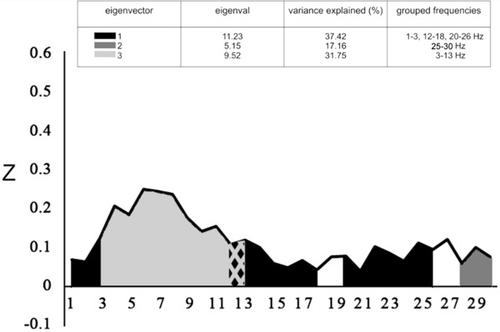当前位置:
X-MOL 学术
›
Am. J. Primatol.
›
论文详情
Our official English website, www.x-mol.net, welcomes your
feedback! (Note: you will need to create a separate account there.)
Principal component analysis of electroencephalographic activity during sleep and wakefulness in the spider monkey (Ateles geoffroyi).
American Journal of Primatology ( IF 2.0 ) Pub Date : 2020-06-18 , DOI: 10.1002/ajp.23162 Manuel Alejandro Cruz-Aguilar 1 , Enrique Hernández-Arteaga 2 , Marisela Hernández-González 2 , Ignacio Ramírez-Salado 1 , Miguel Angel Guevara 3
American Journal of Primatology ( IF 2.0 ) Pub Date : 2020-06-18 , DOI: 10.1002/ajp.23162 Manuel Alejandro Cruz-Aguilar 1 , Enrique Hernández-Arteaga 2 , Marisela Hernández-González 2 , Ignacio Ramírez-Salado 1 , Miguel Angel Guevara 3
Affiliation

|
The study of electroencephalographic (EEG) activity during sleep in the spider monkey has provided new insights into primitive arboreal sleep physiology and behavior in anthropoids. Nevertheless, studies conducted to date have maintained the frequency ranges of the EEG bands commonly used with humans. The aim of the present work was to determine the EEG broad bands that characterize sleep and wakefulness in the spider monkey using principal component analysis (PCA). The EEG activity was recorded from the occipital, central, and frontal EEG derivations of six young‐adult male spider monkeys housed in a laboratory setting. To determine which frequencies covaried and which were orthogonally independent during sleep and wakefulness, the power EEG spectra and interhemispheric and intrahemispheric EEG correlations from 1 to 30 Hz were subjected to PCA. Findings show that the EEG bands detection differed from those reported previously in both spider monkeys and humans, and that the 1–3 and 2–13 Hz frequency ranges concur with the oscillatory activity elucidated by cellular recordings of subcortical regions. Results show that applying PCA to the EEG spectrum during sleep and wakefulness in the spider monkey led to the identification of frequencies that covaried with, and were orthogonally independent of, other frequencies in each behavioral vigilance state. The new EEG bands differ from those used previously with both spider monkeys and humans. The 1–3 and 2–13 Hz frequency ranges are in accordance with the oscillatory activity elucidated by cellular recordings of subcortical regions in other mammals.
中文翻译:

蜘蛛猴(Ateles geoffroyi)在睡眠和清醒期间的脑电图活动的主成分分析。
对蜘蛛猴睡眠期间脑电图(EEG)活性的研究为类人猿原始树栖动物的睡眠生理和行为提供了新见解。然而,迄今为止进行的研究保持了人类通常使用的EEG频带的频率范围。本工作的目的是使用主成分分析(PCA)确定表征蜘蛛猴睡眠和清醒的EEG宽带。脑电图记录了六只在实验室环境中饲养的成年雄性蜘蛛猴的枕叶,中央和额叶脑电图。为了确定在睡眠和清醒期间哪些频率是协变的,哪些频率是正交独立的,对功率EEG频谱以及1至30 Hz的半球和半球内EEG相关性进行了PCA分析。结果表明,脑电图谱带的检测不同于以前在蜘蛛猴和人类中报告的谱带,并且1-3和2-13 Hz的频率范围与皮层下区域的细胞记录所阐明的振荡活性一致。结果表明,在蜘蛛猴的睡眠和清醒过程中将PCA应用于EEG频谱可以识别与每个行为警戒状态下的其他频率共变且正交于其他频率的频率。新的EEG频段不同于以前在蜘蛛猴和人类中使用的频段。1–3和2–13 Hz频率范围与其他哺乳动物皮层下区域的细胞记录所阐明的振荡活动一致。
更新日期:2020-07-24
中文翻译:

蜘蛛猴(Ateles geoffroyi)在睡眠和清醒期间的脑电图活动的主成分分析。
对蜘蛛猴睡眠期间脑电图(EEG)活性的研究为类人猿原始树栖动物的睡眠生理和行为提供了新见解。然而,迄今为止进行的研究保持了人类通常使用的EEG频带的频率范围。本工作的目的是使用主成分分析(PCA)确定表征蜘蛛猴睡眠和清醒的EEG宽带。脑电图记录了六只在实验室环境中饲养的成年雄性蜘蛛猴的枕叶,中央和额叶脑电图。为了确定在睡眠和清醒期间哪些频率是协变的,哪些频率是正交独立的,对功率EEG频谱以及1至30 Hz的半球和半球内EEG相关性进行了PCA分析。结果表明,脑电图谱带的检测不同于以前在蜘蛛猴和人类中报告的谱带,并且1-3和2-13 Hz的频率范围与皮层下区域的细胞记录所阐明的振荡活性一致。结果表明,在蜘蛛猴的睡眠和清醒过程中将PCA应用于EEG频谱可以识别与每个行为警戒状态下的其他频率共变且正交于其他频率的频率。新的EEG频段不同于以前在蜘蛛猴和人类中使用的频段。1–3和2–13 Hz频率范围与其他哺乳动物皮层下区域的细胞记录所阐明的振荡活动一致。











































 京公网安备 11010802027423号
京公网安备 11010802027423号